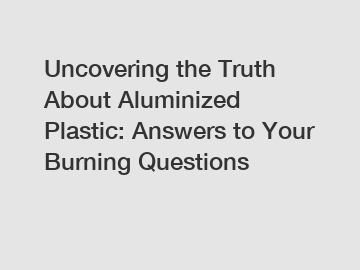Uncovering the Truth About Aluminized Plastic: Answers to Your Burning Questions
Aluminized plastic is a material that has gained popularity in recent years due to its unique properties and applications. However, there is still a lot of confusion and misinformation surrounding this material. In this blog post, we aim to uncover the truth about aluminized plastic and provide answers to some of the burning questions you may have.
What is Aluminized Plastic?
Aluminized plastic is a type of material that consists of a plastic film or substrate that has been coated with a thin layer of aluminum. This coating of aluminum provides the material with a number of unique properties, including increased durability, reflectivity, and resistance to heat and moisture.

One of the most common applications of aluminized plastic is in packaging materials. The reflective properties of the aluminum coating help to keep the contents of the package cool by reflecting heat away from the material. This makes aluminized plastic ideal for packaging perishable goods that need to be kept fresh and cool during transportation and storage.
Is Aluminized Plastic Safe?
One of the biggest concerns that people have about aluminized plastic is whether or not it is safe to use. While it is true that aluminum can be toxic in high doses, the amount of aluminum that leaches from aluminized plastic is minimal and well within the safe limits set by regulatory agencies.
In fact, aluminized plastic is often used in food packaging materials and is considered to be safe for use with food products. The aluminum coating on the plastic provides an additional barrier to moisture and oxygen, helping to keep the food fresh for longer periods of time.
Additionally, aluminized plastic is also widely used in the construction industry for its reflective properties. The aluminum coating on the plastic helps to reflect heat and sunlight, reducing the amount of energy needed to cool a building. This can help to lower energy costs and reduce the carbon footprint of a building.
How is Aluminized Plastic Made?
The process of making aluminized plastic involves coating a plastic film or substrate with a layer of aluminum. This can be done through a number of different methods, including vacuum deposition, sputtering, or chemical vapor deposition.
In vacuum deposition, the plastic film is placed in a vacuum chamber and aluminum is heated until it evaporates. The aluminum vapor then condenses onto the surface of the plastic film, forming a thin layer of aluminum coating.
In sputtering, aluminum atoms are knocked off a solid aluminum target by bombarding it with high-energy particles. These aluminum atoms then deposit onto the plastic film, forming a thin layer of aluminum coating.
In chemical vapor deposition, a gas containing aluminum atoms is flowed over the surface of the plastic film. The aluminum atoms react with the surface of the plastic film, forming a thin layer of aluminum coating.
Each of these methods has its own advantages and disadvantages, but they all result in the same end product - a plastic film or substrate that has been coated with a layer of aluminum.
What are the Benefits of Aluminized Plastic?
There are a number of benefits to using aluminized plastic in various applications. Some of the main benefits include:
- Increased durability: The aluminum coating on the plastic film helps to increase its durability, making it more resistant to tears, punctures, and abrasions.
- Reflectivity: The reflective properties of the aluminum coating help to keep the contents of the package cool by reflecting heat away from the material.
- Resistance to heat and moisture: The aluminum coating on the plastic film provides an additional barrier to moisture and heat, helping to keep the contents of the package fresh and cool.
- Energy efficiency: Aluminized plastic is widely used in the construction industry for its reflective properties, helping to reduce the amount of energy needed to cool a building.
Overall, aluminized plastic is a versatile material that offers a number of benefits in various applications.
In conclusion, aluminized plastic is a unique material that offers a number of benefits in various applications. Despite some misconceptions and concerns, aluminized plastic is safe for use and is widely used in the packaging and construction industries for its durability, reflectivity, and resistance to heat and moisture. Whether you're looking to keep your food fresh during transportation or reduce energy costs in a building, aluminized plastic may be the perfect solution for your needs.
Want more information on bopp film manufacture packaging, white bopp with lamination, china release liners? Feel free to contact us.


